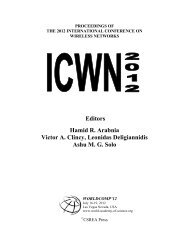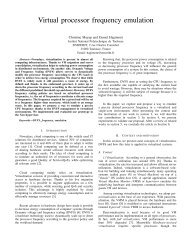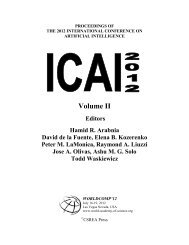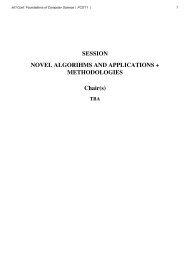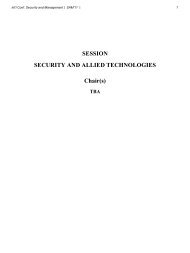SESSION GRAPH BASED AND TREE METHODS + RELATED ...
SESSION GRAPH BASED AND TREE METHODS + RELATED ...
SESSION GRAPH BASED AND TREE METHODS + RELATED ...
- TAGS
- graph
- methods
- world-comp.org
Create successful ePaper yourself
Turn your PDF publications into a flip-book with our unique Google optimized e-Paper software.
48 Int'l Conf. Foundations of Computer Science | FCS'12 |<br />
6.1 Accuracy of ALGO EXGCD<br />
In this section we prove the accuracy of our formalization<br />
that the functor ALGO EXGCD returns a, b and<br />
g for given integers x and y such that ax + by = g(g<br />
is the greatest common divisor of x and y).<br />
We can prove the following theorem in a similarly<br />
for proving Theorem 6.1:<br />
Theorem 6.1 (Accuracy of ALGO EXGCD)<br />
for x,y be Element of INT<br />
holds<br />
ALGO_EXGCD(x,y)‘3 = x gcd y<br />
&<br />
ALGO_EXGCD(x,y)‘1 * x<br />
+ ALGO_EXGCD(x,y)‘2 * y<br />
= x gcd y,<br />
where ALGO EXGCD(x,y)‘n denotes the nth member<br />
of ALGO EXGCD(x,y). Thus we proved the accuracy<br />
of our formalization of extended Euclidean algorithm.<br />
6.2 Multiplicative Inverse<br />
Then, we define the functor that computes the multiplicative<br />
inverse over a residue class ring using the<br />
ALGO EXGCD as follows:<br />
Definition 6.2 (Inverse)<br />
let x,p be Element of INT;<br />
func ALGO_INVERSE(x,p) -> Element of INT<br />
means<br />
for y be Element of INT<br />
st y = (x mod p)<br />
holds<br />
(ALGO_EXGCD(p,y)‘3 = 1 implies<br />
((ALGO_EXGCD(p,y)‘2 < 0) implies<br />
(ex z be Element of INT<br />
st z = ALGO_EXGCD(p,y)‘2<br />
& it = p + z ))<br />
& ( (0



